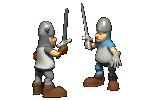History of Braveheart
Home
Characters
William Wallace
King Edward
Robert Bruce
Prince Edward
Isabella of France
Battles
Stirling
Falkirk
Bannokburn
Movie Info
Oscar Page
Script
Videos
Blind Harry
Fact or Fiction Quiz
|
 |
Battle of
Stirling Bridge
|  |
At Stirling the neck of Scotland between the rivers Forth and Clyde
is narrow enough to be a chokepoint and anyone wishing to dominate the
country must hold that chokepoint. It was there, in September 1297, that
the clash came. Wallace's men were mostly of low social status and most
of their weapons were hand made. Few had even a simple steel skullcap to
protect them and none had armor. They had been well drilled though and
wielding 12ft pikes fought in the oval shaped spear-ring called the schilltron. None of Scotland's great lords stood with Wallace that day.
The Scots were drawn up on the slopes of the Abbey Craig, a steep hill
on which the Wallace Monument now stands. Below them the River Forth wandered
across the plain and curved into a large u-bend not a few hundreds of yards
from the base of the hill. The river was crossed by a narrow bridge, only
wide enough to permit the crossing of two horsemen abreast.
When Surrey and Cressingham arrived at the bridge they made a critical
mistake. They had been advised that there was a
ford some way upstream
where a hundred horsemen could cross the river in line abreast, but they
disdained to heed this advice. Perhaps they felt the Scots were little
more than a rabble and would be unable to resist the armored knights and
men-at-arms advancing on them. Some said the stingy Cressingham wished
to waste no more of his king's money in needlessly prolonging the war.
Whatever the reason, the decision to cross the bridge condemned the English
to their fate. Wallace had told his men to stand firm until they heard
the sound of his horn and then to charge with all their might.
It was Cressingham who led the the English vanguard across the bridge.
When they reached the other side of the river the English knights found
the ground there to be soft almost marshy and they had great trouble in
deploying their great warhorses into any semblance of a line. With only
half the army across the bridge and greatly frustrated by the softness of
the ground, Cressingham heard the sound of a horn braying from the slopes
above him and down from the Abbey Craig the Scots spearmen rushed forward.
The English were trapped in the bend of the river, unable to properly form
up and with no hope of aid from their compatriots on the other side of
the river. It was all over in an hour. Pushed back by the spears, the English
horses were stabbed or hamstrung and their riders' throats were cut when
they fell from their mounts. Surrey looked on in impotent fury as his army
was torn to pieces. Cressingham fought fiercely on until he too was dragged
from his horse and slain. Perhaps, as the song suggests, it was Moray who
cut him down; we do not know. What we do know is that Andrew de Moray was
severely wounded in the battle and died of these
|
